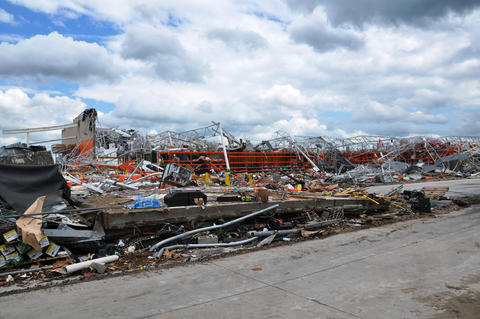
The National Institute of Standards and Technology (NIST) today said that it will conduct a full technical study on the impacts of the May 22, 2011, tornado that struck Joplin, Mo.
The massive tornado was rated category EF5, the most powerful on the Enhanced Fujita scale. According to the National Weather Service (NWS) and the Federal Emergency Management Agency (FEMA), the multiple-vortex storm impacted an area approximately three-quarters of a mile wide by 14 miles long, destroyed some 8,000 structures in its path, and killed more than 150 people. This makes it the single deadliest tornado in the United States in the 61 years that official records have been kept.
"The widespread destruction across a range of building and construction types, along with the tragically large death toll despite a comparatively substantial warning time, makes the Joplin tornado a unique event to research," says Marc Levitan, leader of the NIST study. "The lessons learned will be extremely valuable to national efforts aimed at reducing losses of lives and property from tornados."
From May 25-28, NIST sent four engineers to Joplin to conduct a preliminary reconnaissance of building performance and emergency communications during the tornado. Based on the analysis of the data collected and other criteria required by regulation, NIST Director Pat Gallagher established a research team under the National Construction Safety Team Act to proceed with a more comprehensive study of the impacts of the disaster.
The objectives of the NIST technical study are to:
-
determine the characteristics of the wind hazard from the tornado;
-
determine the pattern, location and cause of injuries and fatalities, and how these numbers were affected by emergency communications and the public response to those communications;
-
determine the performance of residential, commercial and critical (police stations, firehouses, hospitals, etc.) buildings;
-
determine the performance of lifelines (natural gas, electrical distribution, water, communications, etc.) as they relate to maintaining building operation; and
-
make recommendations, if warranted, for improvements to building codes, standards and practices based on the findings of the study.
The same engineers who performed the preliminary reconnaissance will conduct this more extensive study. They will be joined by an expert on severe storms from the Commerce Department's National Oceanic and Atmospheric Administration (NOAA).
Observations and findings from the preliminary reconnaissance suggest the following:
-
The current tornado rating procedure, the Enhanced Fujita intensity scale, lacks adequate indicators for estimating the intensity of tornadoes such as the one in Joplin.
-
The 24-minute warning time for this event was nearly double the national average reported by the NWS as 13-14 minutes.
-
The Joplin siren-based warning system was not intended to alert people who were indoors.
-
There were no designated public safe rooms or tornado shelters in Joplin.
-
Most buildings in Joplin did not have basements.
-
A large number of residential and non-residential buildings in Joplin sustained complete loss of function, requiring either major repair or replacement.
-
Critical and high-occupancy buildings in Joplin did not perform better than buildings of similar construction type in lower-risk categories with regard to loss of function or damage.
-
Reinforced concrete frame and steel frame buildings that were surveyed also suffered total loss of function and major damage to the envelope and interior; however, the structural frame remained largely intact.
-
Most other buildings, including those constructed with pre-cast concrete, metal, concrete and brick masonry, and wood-frame, suffered partial or complete collapse.
Both the NIST preliminary reconnaissance and the upcoming technical study led by NIST build on a partnership between the agency's Disaster and Failure Studies Program and the interagency National Windstorm Impact Reduction Program. For more information on the Joplin tornado study, and NIST's 40-plus years of experience studying structural failures and fires, visit NIST's Disaster Studies page.

